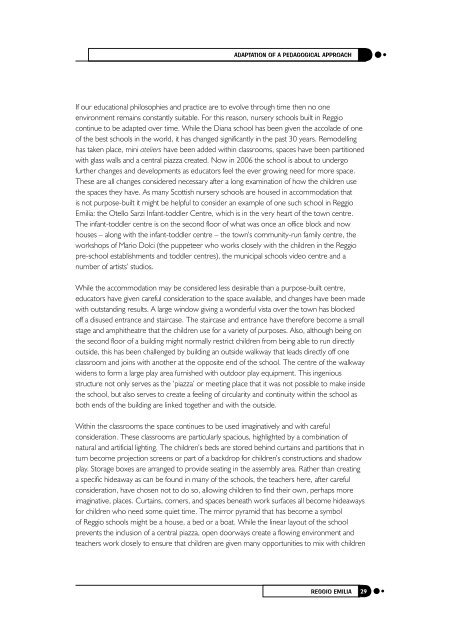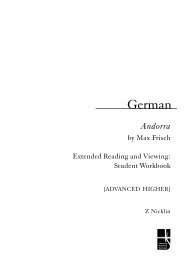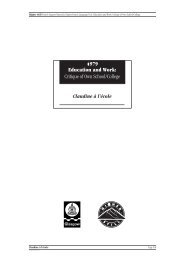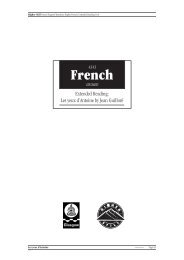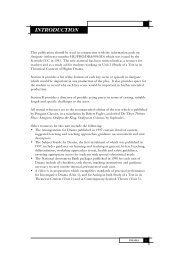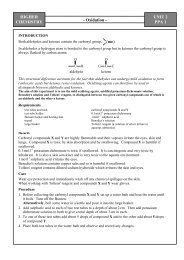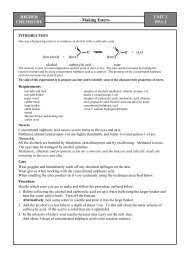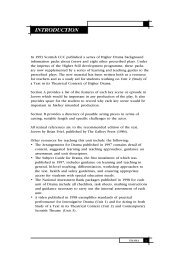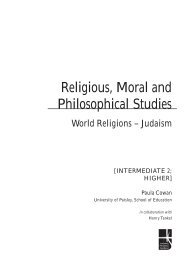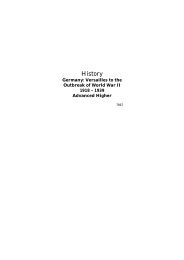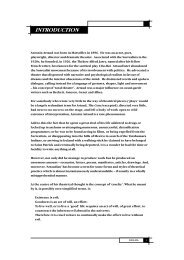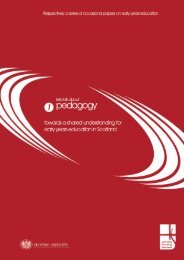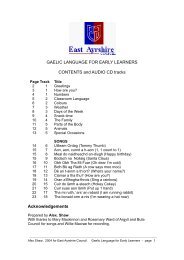The Reggio Emilia Approach to Early Years - Education Scotland
The Reggio Emilia Approach to Early Years - Education Scotland
The Reggio Emilia Approach to Early Years - Education Scotland
Create successful ePaper yourself
Turn your PDF publications into a flip-book with our unique Google optimized e-Paper software.
ADAPTATION OF A PEDAGOGICAL APPROACH<br />
If our educational philosophies and practice are <strong>to</strong> evolve through time then no one<br />
environment remains constantly suitable. For this reason, nursery schools built in <strong>Reggio</strong><br />
continue <strong>to</strong> be adapted over time. While the Diana school has been given the accolade of one<br />
of the best schools in the world, it has changed significantly in the past 30 years. Remodelling<br />
has taken place, mini ateliers have been added within classrooms, spaces have been partitioned<br />
with glass walls and a central piazza created. Now in 2006 the school is about <strong>to</strong> undergo<br />
further changes and developments as educa<strong>to</strong>rs feel the ever growing need for more space.<br />
<strong>The</strong>se are all changes considered necessary after a long examination of how the children use<br />
the spaces they have. As many Scottish nursery schools are housed in accommodation that<br />
is not purpose-built it might be helpful <strong>to</strong> consider an example of one such school in <strong>Reggio</strong><br />
<strong>Emilia</strong>: the Otello Sarzi Infant-<strong>to</strong>ddler Centre, which is in the very heart of the <strong>to</strong>wn centre.<br />
<strong>The</strong> infant-<strong>to</strong>ddler centre is on the second floor of what was once an office block and now<br />
houses – along with the infant-<strong>to</strong>ddler centre – the <strong>to</strong>wn’s community-run family centre, the<br />
workshops of Mario Dolci (the puppeteer who works closely with the children in the <strong>Reggio</strong><br />
pre-school establishments and <strong>to</strong>ddler centres), the municipal schools video centre and a<br />
number of artists’ studios.<br />
While the accommodation may be considered less desirable than a purpose-built centre,<br />
educa<strong>to</strong>rs have given careful consideration <strong>to</strong> the space available, and changes have been made<br />
with outstanding results. A large window giving a wonderful vista over the <strong>to</strong>wn has blocked<br />
off a disused entrance and staircase. <strong>The</strong> staircase and entrance have therefore become a small<br />
stage and amphitheatre that the children use for a variety of purposes. Also, although being on<br />
the second floor of a building might normally restrict children from being able <strong>to</strong> run directly<br />
outside, this has been challenged by building an outside walkway that leads directly off one<br />
classroom and joins with another at the opposite end of the school. <strong>The</strong> centre of the walkway<br />
widens <strong>to</strong> form a large play area furnished with outdoor play equipment. This ingenious<br />
structure not only serves as the ‘piazza’ or meeting place that it was not possible <strong>to</strong> make inside<br />
the school, but also serves <strong>to</strong> create a feeling of circularity and continuity within the school as<br />
both ends of the building are linked <strong>to</strong>gether and with the outside.<br />
Within the classrooms the space continues <strong>to</strong> be used imaginatively and with careful<br />
consideration. <strong>The</strong>se classrooms are particularly spacious, highlighted by a combination of<br />
natural and artificial lighting. <strong>The</strong> children’s beds are s<strong>to</strong>red behind curtains and partitions that in<br />
turn become projection screens or part of a backdrop for children’s constructions and shadow<br />
play. S<strong>to</strong>rage boxes are arranged <strong>to</strong> provide seating in the assembly area. Rather than creating<br />
a specific hideaway as can be found in many of the schools, the teachers here, after careful<br />
consideration, have chosen not <strong>to</strong> do so, allowing children <strong>to</strong> find their own, perhaps more<br />
imaginative, places. Curtains, corners, and spaces beneath work surfaces all become hideaways<br />
for children who need some quiet time. <strong>The</strong> mirror pyramid that has become a symbol<br />
of <strong>Reggio</strong> schools might be a house, a bed or a boat. While the linear layout of the school<br />
prevents the inclusion of a central piazza, open doorways create a flowing environment and<br />
teachers work closely <strong>to</strong> ensure that children are given many opportunities <strong>to</strong> mix with children<br />
REGGIO EMILIA REGGIO EMILIA


